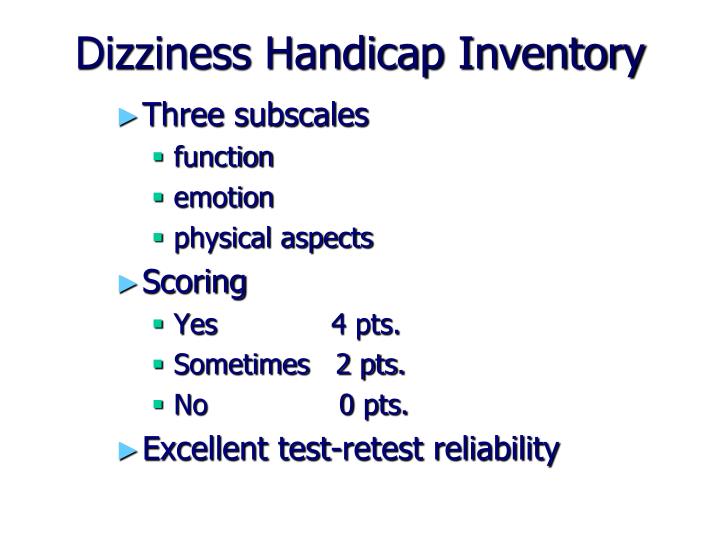



Recommendations for entry-level physical therapy education and use in research: Recommendations based on vestibular diagnosisīenign Paroxysmal Positional Vertigo (BPPV) Recommendations for use based on acuity level of the patient: Reasonable to use, but limited study in target group / Unable to Recommend These recommendations were developed by a panel of research and clinical experts using a modified Delphi process.įor detailed information about how recommendations were made, please visit: Recommendations for use of the instrument from the Neurology Section of the American Physical Therapy Association’s Multiple Sclerosis Taskforce (MSEDGE), Parkinson’s Taskforce (PD EDGE), Spinal Cord Injury Taskforce (PD EDGE), Stroke Taskforce (StrokEDGE), Traumatic Brain Injury Taskforce (TBI EDGE), and Vestibular Taskforce (Vestibular EDGE) are listed below. Four subscales are derived from the questionnaire which measure:ġ) Each item scored on a 5-point scale (range 0-4) and measure of symptom severity is obtained by summing item scoresĢ) To obtain a measure of symptom severity, sum marked responses of the total and/or the respective sub-scalesģ) Mean score: divide sum-score by respective number of scale itemsġ) Two sub-scales: 8 items relating to vertigo-balance (VSS-V score ranging from 0-32), and 7 items relating to autonomic anxiety symptoms (VSS-A, score ranging 0-28)Ģ) Severe dizziness defined as ≥ 12 points on the total scale.Two principal subscales distinguish between items related to vertigo and imbalance (Vertigo symptom scale) as well as items suggestive of anxiety and arousal (Autonomic/Anxiety):ġ) Vertigo/balance sub scale score range: 0-76Ģ) Autonomic/Anxiety subscale score range: 0-60ġ) Total score aims to figure out the severity of dizziness.Frequency of symptoms is rated on a Likert scale:ġ point: “a few times (1-3 times a year)”Ģ points: “several times (4-12 times a year)”ģ points: “quite often (on average, more than once a month)”Ĥ points: “very often (on average more than once a week)”.Mean score: divide sum-score by respective number of scale items.

To obtain a measure of symptom severity, sum marked responses of the total and/or the respective sub-scales. Vertigo/balance sub scale score range: 0-76Īutonomic/Anxiety subscale score range: 0-60įour subscales are derived from the questionnaire which measure:ġ) Acute Vertigo: dizziness or unsteadiness lasting more than one hour sometimes accompanied by falling, nausea and vomitingĢ) Vertigo of short duration: isolated sensations of disorientation or disequilibriumģ) Autonomic symptoms: heart pounding, excessive sweating, feeling fiat or short of breathĤ) Somatization or over reporting of health problems manifested as a tendency to complain of a large number of diverse symptomsĮach item scored on a 5 point scale (range 0-4) and measure of symptom severity is obtained by summing item scores. Two principle subscales distinguishing between items related to vertigo and imbalance (Vertigo symptom scale) and those suggestive of anxiety and arousal (Autonomic/Anxiety). Total score aims to figure out the severity of dizziness. Frequency of symptoms is rated on a Likert scale: 0 points: “never”, 1 point: “a few times (1-3 times a year)”, 2 points: “several times (4-12 times a year)”, 3 points: “quite often (on average, more than once a month)” and 4 points: “very often (on average more than once a week)”. The long version contains 36 items addressing frequency and severity of dizziness symptoms within the last 12 months.


 0 kommentar(er)
0 kommentar(er)
